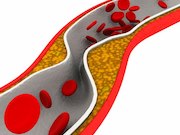Only one significant between-group difference in three-year risk of target-vessel failure for left main CAD
FRIDAY, Feb. 23, 2018 (HealthDay News) — There are few significant differences in target-vessel failure with different types of second-generation drug-eluting stents (DES) for obstructive left main coronary artery disease (LMCAD), according to a study published in the Feb. 27 issue of the Journal of the American College of Cardiology.
Pil Hyung Lee, M.D., from the University of Ulsan College of Medicine in Seoul, South Korea, and colleagues identified 2,692 patients with significant LMCAD from three prospective registries who received second-generation DES: 1,254 with cobalt-chromium everolimus-eluting stents (CoCr-EES), 232 with biodegradable polymer biolimus-eluting stents (BP-BES), 616 with platinum-chromium EES (PtCr-EES), and 590 with zotarolimus-eluting stents (Re-ZES).
The researchers found that there was no significant difference for the observed three-year rates of target-vessel failure for the different types of DES (16.7 percent for the CoCr-EES, 13.2 percent for the BP-BES, 18.7 percent for the PtCr-EES, and 14.7 percent for the Re-ZES; P = 0.15). In between-group comparisons of the different DES, the adjusted hazard ratios for target-vessel failure were similar, except for the PtCr-EES versus the BP-BES (reference, hazard ratio, 1.6; 95 percent confidence interval, 1.01 to 2.54; P = 0.046) in multiple treatment propensity score analysis.
“In this pooled analysis of three prospective registries involving unrestricted use of various second-generation DES for LMCAD, we found no significant between-group differences in three-year risk of target-vessel failure, except for a higher risk of primary outcome with PtCr-EES compared to BP-BES,” the authors write.
Copyright © 2018 HealthDay. All rights reserved.








